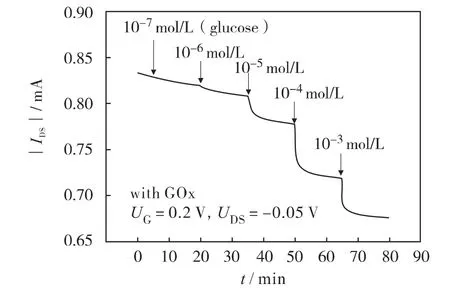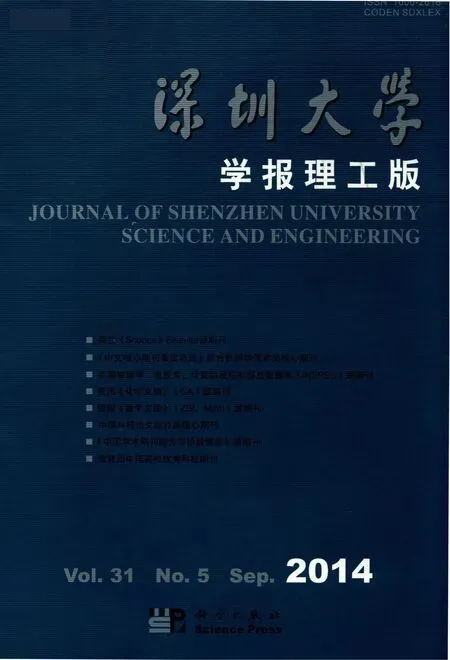Glucose sensors based on solution-gated graphene transistors
Lin Peng,Dai Jiajia,Wang Hairui,Ke Shanming†,and Zeng Xierong†
1)College of Materials Science and Engineering,Shenzhen University,Shenzhen 518060,P.R.China
2)Shenzhen Key Laboratory of Special Functional Materials,Shenzhen Engineering Laboratory for Advanced Technology of Ceramics,Shenzhen 518060,P.R.China
Glucose sensors based on solution-gated graphene transistors
Lin Peng1,2,Dai Jiajia1,2,Wang Hairui1,2,Ke Shanming1,2†,and Zeng Xierong1,2†
1)College of Materials Science and Engineering,Shenzhen University,Shenzhen 518060,P.R.China
2)Shenzhen Key Laboratory of Special Functional Materials,Shenzhen Engineering Laboratory for Advanced Technology of Ceramics,Shenzhen 518060,P.R.China
A solution-gated graphene field effect transistor is used to develop a sensitive glucose sensor.The sensor can be used for the determination of glucose with a concentration of as low as 1×10-6mol/L without any nanomaterial modification for the Pt gate electrode.With some advantages like low-cost,easy fabrication,low working voltage,and good biocompatibility,this type of biosensor will be an excellent candidate for the applications of enzymatic sensing.
biosensor;graphene;glucose;solution-gated;field effect transistor;detection limit
Graphene has been widely investigated in recent years due to its excellent physical,chemical,mechanical,and electronic properties[1].With a nanostructure of one-atom-thick and twodimensional carbon sheet,graphene exhibits many advantages like large specific surface area,remarkable electrical conductivity,excellent chemical stability,and good biocompatibility[2].Therefore,graphene shows potential applications in chemical and biological sensors with high sensitivity,high selectivity,and prompt response time.More recently,graphenebased transistors have also been investigated for sensor applications.With some advantages like low operating voltage(less than 1 V)and solution stability,solution-gated graphene field effect transistors(SGGT)have been developed in bio-sensing,such as cell-based biosensor[3],DNA sensor[4],and bacteria sensor[5].In this paper,we report a sensitive glucose sensor based on SGGT,in which glucose oxidase(GOx)is immobilized on platinum(Pt)gate electrode.The sensor can detect glucose concentration as low as 1×10-6mol/L even without any nanomaterial modification for the gate electrode.
1 Experiment
1.1 Device fabrication
Cr/Au source/drain electrodes were deposited on SiO2/Si substrate through a shadow mask with a thermal evaporator(Edwards Auto 306).The channel length and width of the devices were 0.2 mm and 6.0 mm,respectively.Then graphene film was transferred onto the source/drain electrodes.Finally,a poly(dimethylsiloxane)(PDMS)wall was attached to the SiO2/Si substrate to contain phosphate-buffered saline(PBS,100 mmol/L NaCland 10 mmol/L sodium phosphate,pH=7.0)during the electrical measurements,as shown in Fig.1.

Fig.1 (Color online)Schematic diagram of a SGGT fabricated on SiO2/Si substrate[7]图1 制备在SiO2/Si衬度上的SGGT器件示意图[7]
1.2 Gate electrode fabrication
GOx was dissolved in PBS solution with a concentration of 10 mg/mL.Then 20 μL GOx solution was drop-coated onto the surface of Pt gate electrode and dried at 4℃ for 12 h.Chitosan(CHIT)was dissolved in acetic acid solution with a concentration of 5 mg/mL.In order to improve the immobilization of GOx on Pt electrode,20 μL CHIT solution was then dropcoated onto the surface of GOx/Pt electrode and dried at 4℃for 12 h.After the CHIT film was formed,the CHIT/GOx/Pt electrode was rinsed thoroughly with de-ionized water and stored at 4 ℃ for future use.
1.3 Electrical measurements
The devices were characterized with a semiconductor parameter analyzer(Agilent 4156C).The PBS solution was used as an electrolyte.For transfer characteristics,the channel current IDSbetween source and drain was measured as a function of gate voltage UGunder a constant drain voltage UDS=-0.05 V.For sampling characteristics,IDSwas measured as a function of time under a constant drain voltage UDS=-0.05 V and a constant gate voltage UG=0.2 V.
2 Results and discussions
Fig.1 shows the schematic diagram of a SGGT fabricated on SiO2/Si substrate.The device is firstly characterized in PBS solution and bare Pt is selected as gate electrode.It can be found that the device shows very stable performance in PBS solution and the response time is less than 1 s.The transfer characteristic(IDS-UG,UDS=-0.05 V)of the device is shown in Fig.2.We can find that the conductance of the device exhibits ambipolar behavior when the gate voltage is applied within 1 V.The Dirac point of the transfer curve is at around 0.7 V.

Fig.2 Transfer characteristic of the device measured in PBS solution图2 器件在PBS溶液中的U-I特性
Then SGGT device with CHIT/GOx/Pt electrode is used for glucose sensing.Fig.3 shows the channel current(IDS)as functions of time(UDS=-0.05 V,UG=0.2 V)when glucose with different concentration is added into PBS solution.We can find that IDSdecreases with the addition of glucose.The detection limit of the device for glucose is 1×10-6mol/L.A control experiment is conducted when using Pt gate electrode without immobilization of GOx.It can be found that there is nearly no change for the channel current when glucose with different concentration is added into PBS solution.Therefore,the determination of glucose by our device is attributed to the GOx on Pt gate electrode.

Fig.3 IDSas function of time when glucose with different concentration was added into PBS solution图3 器件作为葡萄糖传感器的电学特性
Here we discuss the mechanism of the glucose sensor behavior based on SGGT.The chemical reactions near the gate electrode are shown as follows:

D-glucose is catalyzed by GOx with producing H2O2and D-glucono-1,5-lactone.H2O2is then decomposed at the gate electrode,which leads to the electron transfer on the surface of the gate electrode.As a result,the effective gate voltage applied on the SGGT device changes,leading to the change of the channel current(IDS)of the device[6-8].As SGGT has many advantages like low-cost, easy fabrication, low operating voltage,and good biocompatibility,it will be the excellent candidate for the applications in bio-sensing.
Conclusions
SGGT is exploited for the determination of glucose.The detection limit of the sensor is 1×10-6mol/L when Pt gate electrode without any nanomaterial modification is used.The sensor response is attributed to the decomposition of H2O2at Pt gate electrode.The detection limit of the sensor can be also improved by the modification of gate electrode with nanomaterials.Moreover,this type of biosensor shows potential applications in enzymatic sensing.
Acknowledgement:We thank professor Yan Feng from the Hong Kong Polytechnic University for his guidance in this work.
[1]Novoselov K S,Geim A K,Morozov S V,et al.Electric field effect in atomically thin carbon films [J].Science,2004,306(5696):666-669.
[2]Stankovich S,Dikin D A,Dommett G H B,et al.Graphene-based composite materials [J].Nature,2006,442:282-286.
[3]Cohen-Karni T,Qing Quan,Li Qiang,et al.Graphene and nanowire transistors for cellular interfaces and electrical recording [J].Nano Letters,2010,10(3):1098-1102.
[4]Dong Xiaochen,Shi Yumeng,Huang Wei,et al.Electrical detection of DNA hybridization with single-base specificity using transistors based on CVD-grown graphene sheets[J].Advanced Materials,2010,22(14):1649-1653.
[5] Huang Yinxi,Dong Xiaochen,Liu Yuxin,et al.Graphene-based biosensors for detection of bacteria and their metabolic activities [J].Journal of Materials Chemistry,2011,21:12358-12362.
[6]Lin Peng,Yan Feng,Helen L W Chan.Ion-sensitive properties of organic electrochemical transistors[J].ACS Applied Materials& Interfaces,2010,2(6):1637-1641.
[7]Lin Peng,Yan Feng,Yu Jinjiang,et al.The application of organic electrochemical transistors in cell-based biosensors[J].Advanced Materials,2010,22(33):3655-3660.
[8] Lin Peng,Luo Xiaoteng,Hsing I-Ming,et al.Organic electrochemical transistors integrated in flexible microfluidic systems and used for label-free DNA sensing[J].Advanced Materials,2011,23(35):4035-4040.
基于电解质门控石墨烯晶体管的葡萄糖传感器
林 鹏1,2,戴佳佳1,2,王海瑞1,2,柯善明1,2,曾燮榕1,2
1)深圳大学材料学院,深圳 518060;2)深圳市特种功能材料重点实验室,深圳陶瓷先进技术工程实验室,深圳 518060
利用电解质门控石墨烯场效应晶体管制备了一种高灵敏的葡萄糖传感器.即使不采用纳米修饰的铂金栅电极,这种传感器对葡萄糖的检测极限已可达到1×10-6mol/L.该器件具备成本低、易制备、工作电压低及生物兼容性好等优点,可广泛用于酶生物传感器的研究.
生物传感器;石墨烯;葡萄糖;电解质门控;场效应晶体管;检测极限
国家自然科学基金资助项目 (21405106,51272161)
林 鹏 (1982—),男 (汉族),福建省福清市人,深圳大学材料学院副教授、博士.E-mail:lin.peng@szu.edu.cn
/References:
Q 819
A
10.3724/SP.J.1249.2014.05452
2014-08-28;
2014-09-08
Foundation:National Natural Science Foundation of China(21405106,51272161)
†
Associate professor Ke Shanming,E-mail:smke@szu.edu.cn;Professor Zeng Xierong,E-mail:zengxier@szu.edu.cn.
:Lin Peng,Dai Jiajia,Wang Hairui,et al.Glucose sensors based on solution-gated graphene transistors [J].Journal of Shenzhen University Science and Engineering,2014,31(5):452-454.
引 文:林 鹏,戴佳佳,王海瑞,等.基于电解质门控石墨烯晶体管的葡萄糖传感器[J].深圳大学学报理工版,2014,31(5):452-454.(英文版)
【中文责编:晨 兮;英文责编:新 谷】

